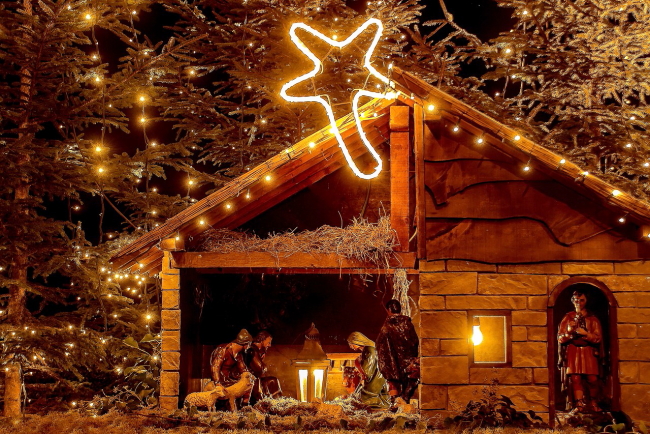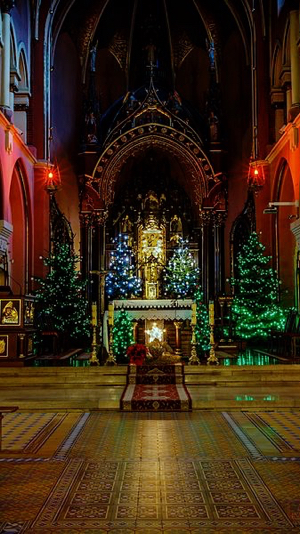SATURDAY, DECEMBER 25: Sing for joy and ring the bells—it’s Christmas! The Old English Christ’s Mass celebrates the birth of Jesus Christ for Christians worldwide, hailing from snow-covered mountains to sandy beaches, crowded cities to rural fields—and everywhere in between.
Central to the liturgical year, Christmas closes Advent and begins the Twelve Days of Christmastide. Though the exact year of Jesus’ birth can’t be placed, Christian families re-read two Gospels that describe a lowly manger, visiting shepherds, magi and, of course, that mysterious guiding star (now believed to have been a rare alignment of planets). While previously a time of year when winter Solstice was celebrated in the Roman empire, Christians transformed this darkest period of the year and say that Jesus’ coming fulfills ancient prophesy that a “Sun of righteousness” would come, and that his (red) blood and (green) eternal life provide hope to the whole world. Even St. Peter’s Basilica at the Vatican boasts an impressive mosaic of Christo Sole, Christ the Sun, in its pre-4th-century necropolis.
Earliest evidence of a Christmas celebration centered around Jesus dates to 354 CE, when events took place in Rome (note that the birth of Christ was already being observed at this time by Eastern Christians, on Epiphany). The first Christmas hymns emerged in 4th century Rome, but the Epiphany holiday continued to dominate Christmas through the Middle Ages. During the medieval period, Christmas grew in popularity over Epiphany. During this time, the 40 days prior to Christmas became known as the “forty days of St. Martin”—a tradition that evolved into Advent.
CHRISTMAS DIY: DECORATIONS, RECIPES & PARTY TIPS
Whether your halls are decked to the hilt or boasting a sparse sprig of holly, have no fear—there’s still time to bring cheer to your home! We’ve searched the web and spotted these online gems that are worth a click and a look …
Martha Stewart offers a selection of handmade gift ideas, ornament inspirations and more. After the stockings and wreaths are hung, it’s time to focus on the Christmas meal—an all-important aspect to Christmas in many cultures. In areas of Italy, 12 kinds of fish are served on Christmas Eve (get Italian Christmas recipes here), while in England, fare often includes goose, gravy, potatoes, bread and cider. Whether Midnight Mass interrupts your menu or not, don’t forget dessert—American cookies, traditional pudding, fruit cakes and mince pies. (Taste of Home and AllRecipes offer everything from appetizer to dessert recipes.)
Cooking for guests with special requests? Find a gluten-free menu and a vegetarian menu from Huffington Post. In Malta, a chocolate and chestnut beverage is served after the 12 a.m. Christmas services.
DID YOU KNOW?
• Sancte Claus was retroactively named the patron saint of Nieuw Amsterdam (the Dutch name for New York City) in 1809
• President Ulysses S. Grant declared Christmas a federal holiday in the United States in 1870. Five years later, the first American Christmas card was produced
• Charles Dickens sought to recreate Christmas as a family centered holiday of generosity and secularity. Unlike modern-day Europe and U.S., workers in Dickens’ day did not get “days off” in their work schedules. In addition to campaigning for a full-day December 25 holiday in A Christmas Carol, Dickens was one of the leading British activists for Sunday-holiday laws in the UK that would give workers a weekly sabbath off work. So, there was a major political campaign behind Dickens’ fanciful tales.

